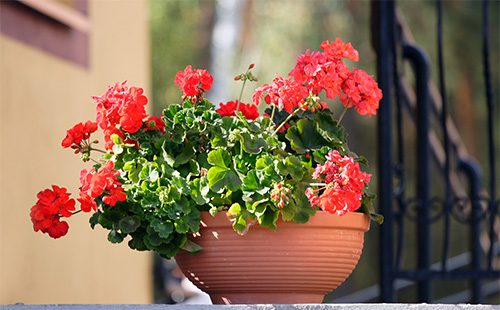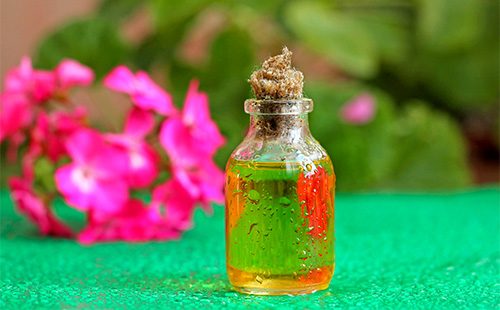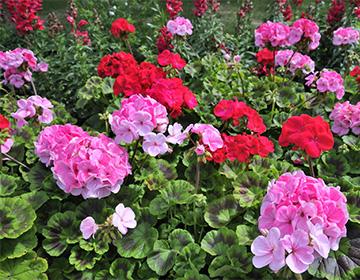The content of the article
On the territory of Russia, geraniums are called small hands. The species name of the plant popular in folk medicine is fragrant or indoor pelargonium. The greenery of the plant exudes a pronounced spicy smell. It is cultivated in the warm countries of the East and the Mediterranean to produce valuable essential oil.
Botanical characteristics and species diversity
There are many types of culture. In England alone, about 1000 varicolored varieties were bred. Room (fragrant) accounts for about 150 of them. Today, there are plant variants with a diverse aroma - almond, pink, cinnamon, ginger. And the aesthetic value of hybrids is very high. However, for traditional medicine, ordinary room geranium is of value, since the concentration of a specific essential oil in it is much higher. In the wild in the middle zone of the country, you can find other types that are significant for medicine.
- Lemon. It grows in a spreading bush, has large green leaves. Another name, pink pelargonium, is given for the color of flowers. Exudes a pronounced lemon flavor. Blooms rarely, but the leaves are used to make teas, brewed as an antiseptic. Grown in room conditions.
- Swamp. Very bright view, growing on moist soils, along marshes, rivers, on the swampy shores of lakes. It occurs mainly in the southern zone of Europe. It is characterized by anti-inflammatory, wound healing and astringent properties. Herbalists rarely harvested.
- Meadow. Other names - field geranium, crane. It occurs on wet slopes, forest edges, in warm climatic conditions. Valued in traditional medicine for a whole range of useful properties - antitumor, anti-inflammatory, regenerating, astringent. It is used internally for diseases of the gastrointestinal tract, hormonal disorders in women, bleeding, for accelerated healing of fractures. Topically used for skin lesions, bacterial and fungal infections, as well as for joint pain.
- Forest. It is rarely used in folk medicine. However, it is valued for its ability to quickly eliminate diarrhea, relieve intestinal inflammation, and eliminate rheumatic pains. On the territory of Russia it is found in the Caucasus, as well as in some regions of Siberia.
- Red It is used for internal bleeding, nasal, for accelerated healing of bleeding wounds and ulcers. Valued in cosmetology for the ability to stop hair loss. In folk medicine, it is used in the treatment of infertility.
Composition
Indoor pelargonium is not considered a medicinal plant. However, its unique multicomponent composition has been studied in detail by botanists. The therapeutic properties of a flower are determined by its essential oil content. Its main component, volatile alcohol geraniol, has pronounced antiseptic and anti-inflammatory properties, in low concentrations it has a beneficial effect on the functioning of the nervous system. High doses of ether are toxic. Geraniol can cause CNS depression, headaches, cramps. When used correctly, this does not happen, but it is impossible to use preparations from the flower in high doses and over a long period.
Other useful substances in the chemical composition of the fingers:
- resinous compounds;
- pectins;
- tannins;
- glycosidic compounds;
- coumarins;
- saponins;
- vitamins and minerals;
- chlorophyll;
- gums;
- polysaccharides.
Healing properties
The flower has a powerful antimicrobial effect. Essential oil is active against viruses, bacteria, fungi, parasites, protozoa. Beneficial substances stimulate the immune system and contribute to the fight against infectious diseases. Internal use of room pelargonium may be appropriate in the following cases.
- ODE problems. Geranium promotes the fusion of bones and prevents their destruction. It also relieves joint inflammation, slows down dystrophic processes, strengthens joint bags. Used for gout, radiculitis, osteochondrosis, rheumatism, arthrosis and arthritis. Also, the plant and the juice from it are used to treat neuralgia.
- Gynecological pathology. Pelargonium preparations are taken orally to stop and prevent uterine, intestinal, pulmonary bleeding. Also used to treat gynecological inflammation, malignant neoplasms, ovarian cystswith mastopathy. External use for the treatment of mucous membranes in bacterial and fungal infections of the mucosa is not excluded. The plant treats PMS, heavy painful periods, relieves irritability with menopause.
- CNS disease. Against insomnia, neurasthenia, irritability, chronic fatigue, mental stress, geranium essential oil works well. In case of disorders in the nervous system, plant preparations are taken orally, and ether is also added to the bathtubs.
Importance in Cosmetology
The cosmetological properties of culture have long been known. The plant is used to restore the beauty of hair. Shampoos and balms are enriched with ether to make hair smooth and prevent its cross-section.A few drops are added to the main oil and used as a mask (they are thoroughly rubbed into the scalp, insulated, worn for up to an hour). In addition to giving shine and smoothness, geranium ether is appreciated for such actions:
- accelerates hair growth;
- eliminates dandruff;
- treats itching and peeling of the scalp;
- prevents pediculosis;
- stops baldness;
- makes hair thicker.

Other benefits of essential oil
Vapors of essential oil are inhaled to normalize sleep and eliminate symptoms of fatigue, relaxation after excessive nervous tension. The product is applied to a napkin, cold and warm inhalations are made, adding up to four drops of ether in cold or warm water.
Drop by drop twice a day, the oil is taken in a mixture with water to strengthen immunity and accelerate recovery from SARS. With a solution, gargle with tonsillitis, make compresses on the wounds. As a remedy for cellulite, seven drops of oil are added per 50 ml of the base, up to ten drops in tonic baths.
Prescription Drugs
Pelargonium preparations are prepared mainly from the leaves of the plant, although there are recipes with flowers, roots, stems. Essential oil is produced industrially. It is sold in pharmacies. The easiest way to use the healing power of a plant is to grind a leaf in your hands. It can be applied to sore spots in such cases:
- joint pain
- intercostal neuralgia;
- itchy skin;
- a bite of an insect;
- bruises and abrasions;
- minor scratches and cuts;
- boils;
- inflamed acne.
There is a practice of using leaves of Kalachik with ear pain. The sheet is kneaded in the hand, rolled up into a lump or tube, driven shallow into the ear. Such a medicine alleviates the condition, eliminates the inflammatory process, partially destroys microbes with infectious otitis media.
Dough
Features A special compress is prepared for severe ear pain. But it has a warming effect, which is inappropriate for bacterial lesions of the middle ear. Use the method only after consulting a doctor, making sure that the thermal effect does not exacerbate the situation.
Preparation and use
- Several large leaves of geraniums are crushed, crushed in a mortar until a pulp is obtained.
- The ground leaves are mixed with a spoon of camphor alcohol.
- Gradually add flour to the mixture (a good non-sticky, but plastic dough should be obtained).
- The mass is crushed to obtain a kind of thick pancake. Apply to a sore ear, insulate with a bag and fabric bandage. Leave to work for an hour.
Decoction
Features The medicine is used as a mild diuretic, for digestive and intestinal disorders, for gargling, and washing the wounds. As raw materials, you can take dry or fresh leaves, fresh roots of the plant.
Preparation and use
- A tablespoon of raw materials is poured with a glass of boiling water.
- Immediately put the container on fire, bring to a boil, boil for one minute.
- Insist half an hour, filter.
- Use externally or take a tablespoon up to five times a day.
Water extraction from the root
Features The drug is taken for all indications characteristic of room pelargonium, is used externally to eliminate skin problems, and is also used in the treatment of hypertension.
Preparation and use
- A tablespoon of the roots is poured with a glass of boiled water, put on fire, heated for four minutes.
- Insist, warming with a towel, about two hours.
- After filtering, the whole composition is taken per day, dividing it into four doses.

Alcohol leaf extract
Features Alcohol extract can be used to treat neurological disorders, joint diseases, and gynecological problems. In diluted form, tincture is applied externally.
Preparation and use
- Fine geraniums finely chopped with a knife or cut with scissors.
- Three tablespoons of raw materials with a slide pour 0.5 liters of quality vodka.
- Insist at room temperature in a dark place for a week.
- After filtering, take half a teaspoon twice a day for therapeutic and prophylactic purposes.
In folk medicine, there is the practice of stopping bleeding with the help of hands. To do this, finely chopped leaves are squeezed through cheesecloth or squeezed juice under a press. 20 drops of the resulting substance are diluted in water (required!). Take the drug in this dose every two hours. However, doctors recommend urgent treatment of a hospital for symptoms of bleeding, as folk remedies can cause a delay and aggravation of the situation. At the same time, doctors advise applying the juice externally to treat wounds and rashes, also previously diluting the squeeze with water.

